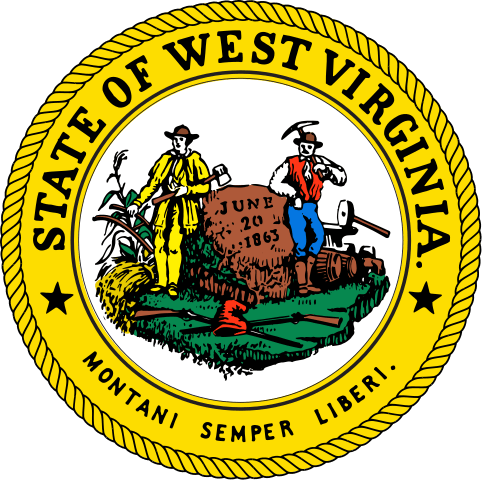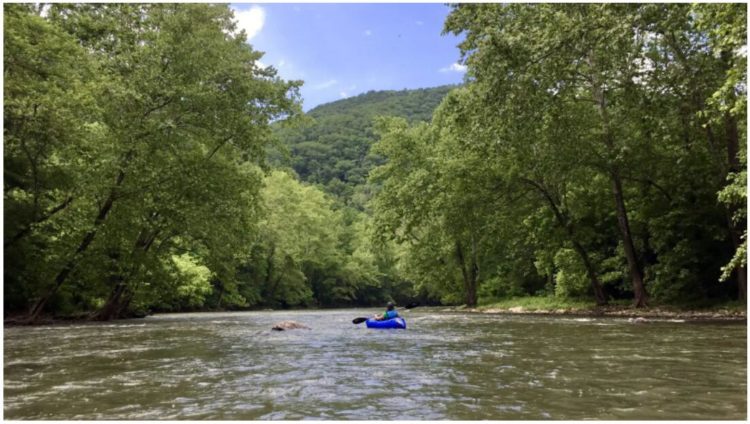West Virginia is a federal state of the United States in the Appalachian region, popularly known as The Mountain State. West Virginia, which separated from Virginia in the Civil War, is also known as a mining region, as well as for its labor disputes and relative poverty.
| Area | 62,755 km² |
| Residents | 1,831,102 |
| Residents per km² | 29.2 |
| Capital | Charleston |
| Postal Code | WV |
| ISO-3166-2 code | US-WV |
| FIPS code | 54 |
Geography
West Virginia is located in the eastern United States between Virginia in the southeast and south, Kentucky in the southwest, Ohio in the northwest, and Pennsylvania and Maryland in the northeast. The northernmost part of the state forms a narrow strip between Ohio and Pennsylvania and is therefore known as the “panhandle” (pan handle). The border with Ohio is formed by the upper reaches of the Ohio River, the border with Maryland by the North Branch of the Potomac River.
The state lies entirely in the Appalachian Mountains, which is why it is nicknamed the “mountain state”. The highest point is the Spruce Knob at 1,482 m, with West Virginia an average of 455 m above sea level, which is the highest value for a state east of the Mississippi.
History
West Virginia’s emergence is unique in United States history. It belonged to Virginia until the Civil War. Ever since the settlement of this part of the country, however, there have been political differences between the rather poorer smallholders in this mountainous region and the plantation owners in the plains that were dominant in state politics. After the outbreak of the American Civil War and the breakaway of Virginia from the Union, the western counties separated from their mother state on April 27, 1861. Representatives of these administrative districts formed a new government, which took its seat in Alexandria, Virginia.
During the Civil War, West Virginia was the site of numerous battles and skirmishes. In 1870, after Virginia had been re-admitted to the Union with all rights, the Supreme Court presupposed the legality of the secession of West Virginia in a court judgment on the affiliation of the two counties Berkeley and Jefferson to West Virginia.
The residents of West Virginia self-ironically refer to their state as the Ireland of the United States. Because the area is rural and characterized by poor conditions. For generations, the profits from the rich wood and coal deposits flowed into the vaults of monopoly trusts, without a large part of the population having received even a modest share in it. When, at the end of the 19th century, the railroad had penetrated from the east into the mountain regions, this transport advantage was used to clear large areas of the forests.
In the 19th century, the principle of the Company Town developed among the large coal mining companies in the south of the state. There the workers received a wage, but had to pay a large part for food and accommodation in towns where most of the money belonged to the coal companies. In addition, the employers gradually lowered wages, so that the exploitation and indebtedness of the workers became more and more oppressive over time. The result was heavy labor disputes, the so-called Mine Wars (mining wars). In these conflicts the unions were fought and held down with military aid.
It was not until 1967 that West Virginia was forced by the Supreme Court to become one of the last states in the United States to lift the ban on mixed marriages.
Economy
The population of West Virginia is traditionally one of the poorest in the US states. The real gross domestic product per capita (per capita GDP) – the most important indicator of prosperity – was USD 40,071 in 2016 (national average of the 50 US states: USD 57,118; national ranking: 48). Only Mississippi is always behind West Virginia in the state rankings.
The unemployment rate was 5.3% in November 2017 (national average: 4.1%).
The once gorgeous forests were cut down for a long time. Afforestation has shown success in the last few decades. Mining (especially hard coal; furthermore natural gas, oil) still plays an important role, but 50 percent of the state’s income is already generated by tourism.
A growing nuisance is the coal extraction in the open pit, which is called “brutal” by environmentalists, the so-called “Mountaintop Removal Mining”. To this end, mountain peaks are cut down and loosened by blasting, especially in the south-west of the state, the earth and rock material is cleared and emptied into sinks in order to access the coal seams more cheaply than in traditional underground mining. There is enormous environmental damage with this method, entire villages are at risk from water and mud falls.
D ie restoration of the exploited stock has been legally mandatory, but is performed not always quickly. In this way, mountainous and sparsely populated West Virginia has got a number of golf courses that would otherwise have hardly been built.
West Virginia Flag
The flag of the US state of West Virginia was introduced on March 7, 1929.
It shows the seal of West Virginia in the middle of a blue-edged white flag cloth.
The flag goes back to merchants who painted a flag for their stand at a St. Louis sales fair in 1904. In the middle it shows the state seal from 1863, which is framed by rhododendron, the official flower of the state. White stands for purity and the blue for the Union.
A boulder is shown in the center of the seal showing the date June 20, 1863, the day West Virginia became a state. The two men to the right and left of the rock represent agriculture and mining. Two rifles and a Phrygian cap are depicted below the rock.
The Latin motto of the state is written in a banner:
“ Montani semper liberi. ”
“ Mountain dwellers are always free. ”
Also known as Mountain State, West Virginia is short for WV with a population of 1,808,344. The capital city and the biggest city of West Virginia is Charleston.

